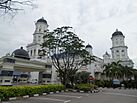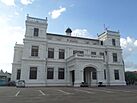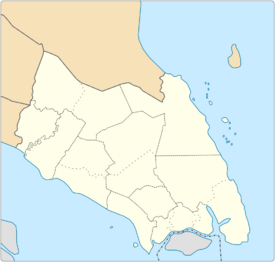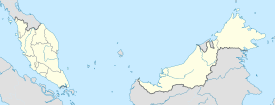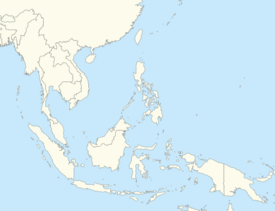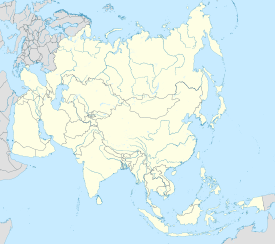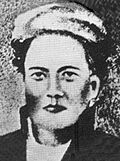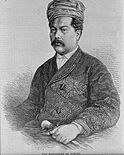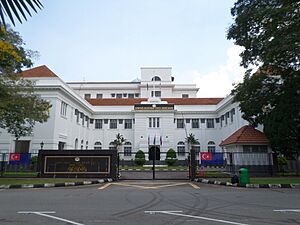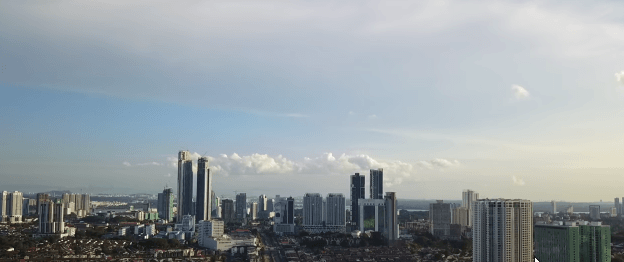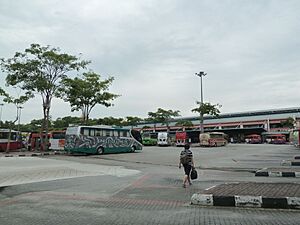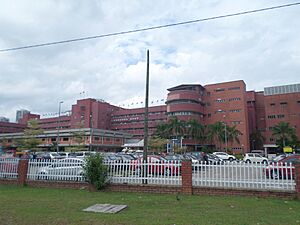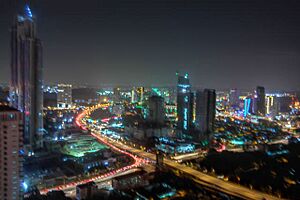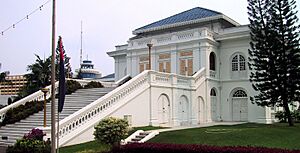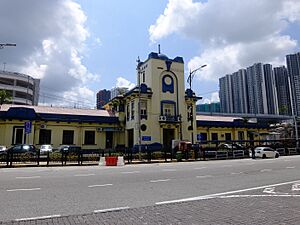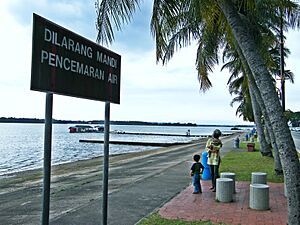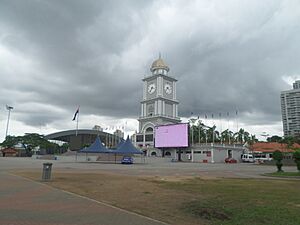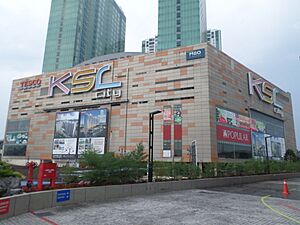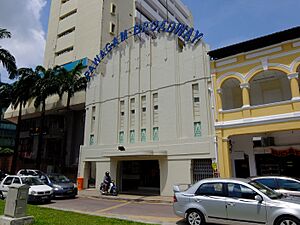Johor Bahru facts for kids
Quick facts for kids
Johor Bahru
|
|||
|---|---|---|---|
|
State capital city and district capital
|
|||
| City of Johor Bahru Bandaraya Johor Bahru |
|||
| Other transcription(s) | |||
| • Jawi | جوهر بهارو | ||
| • Chinese | 新山 (Simplified) 新山 (Traditional) Xīnshān (Hanyu Pinyin) |
||
| • Tamil | ஜொகூர் பாரு Jokūr Pāru (Transliteration) |
||
|
From top, left to right:
Downtown skyline at night, Johor-Singapore Causeway and Johor Bahru Sentral the transport hub in Southern Integrated Gateway, Skyline of the city centre, Forest City (Hutan Bandar) Recreational Park, Danga Bay, the Sultan Ibrahim Building, the Sultan Abu Bakar Mosque, and the Figure Museum |
|||
|
|||
| Nickname(s):
JB,
Bandaraya Selatan (Southern City) |
|||
| Country | |||
| State | |||
| District | |||
| Administrative areas |
List
|
||
| Founded | 10 March 1855 (as Tanjung Puteri) |
||
| Establishment of the local government | 1933 | ||
| Establishment of the Town Board | 1950 | ||
| Municipality status | 1 April 1977 | ||
| City status | 1 January 1994 | ||
| Government | |||
| • Type | City council | ||
| • Body | Johor Bahru City Council | ||
| Area | |||
| • Total | 391.25 km2 (151.06 sq mi) | ||
| Elevation | 32 m (105 ft) | ||
| Population
(2020)
|
|||
| • Total | 858,118 | ||
| • Density | 2,192/km2 (5,680/sq mi) | ||
| Demonym(s) | Johor Bahru | ||
| Time zone | UTC+8 (MST) | ||
| • Summer (DST) | UTC+8 (Not observed) | ||
| Postal code |
80xxx to 81xxx
|
||
| Area code(s) | 07 | ||
| Vehicle registration | J | ||
Johor Bahru (Malaysian: [ˈdʒohor ˈbahru]), colloquially referred to as JB, is the core city of Johor Bahru District, and the capital city of the state of Johor, Malaysia (the second-largest district in the country, by population). It is the second-largest national GDP-contributor among the major cities in Malaysia, and forms a part of Iskandar Malaysia, the nation's largest special economic zone, by investment value. The city has a population of 858,118 people within an area of 391.25 km2.
As the financial centre and logistics hub of southern Peninsular Malaysia, Johor Bahru has been ranked the second-most competitive city in the nation behind the capital, Kuala Lumpur. Geographically, it is located at the southern end of the Malay Peninsula, along the north bank of the Straits of Johor, north of the city-state metropolis of Singapore, specifically Woodlands. Johor Bahru serves as one of two international border crossings, on the Malaysian side, between the country and Singapore, making it the busiest international border crossing in the world; its direct land link to Singapore, via the JB-Woodlands Causeway (the other being the (Tuas) Second Link at Iskandar Puteri), KTM Intercity (Shuttle Tebrau) and the future RTS Link (under construction), is a key economic driver of the border city. Johor Bahru is categorised as Zone A of Iskandar Malaysia, adjacent to Senai International Airport and the 16th-busiest port in the world, Tanjung Pelepas.
During the reign of Sultan Abu Bakar (between 1886–1895), there was further development and modernisation within the city, with the construction of administrative centres, offices, schools, civic and religious buildings, and railways connecting to Woodlands in Northern Singapore. Along with most of Southeast Asia, Japanese forces occupied Johor Bahru from 1942 to 1945 during the Pacific War. Johor Bahru thus became the post-war cradle of Malay nationalism, and a major political party (known as the United Malays National Organisation, or UMNO) was founded at the Istana Besar of Johor Bahru in 1946. After the formation of modern Malaysia in 1963, Johor Bahru retained its status as state capital, and was eventually granted city status, in 1994.
Contents
Etymology
The present area of Johor Bahru was originally known as Tanjung Puteri, and was a fishing village of the Malays. Temenggong Daeng Ibrahim then renamed Tanjung Puteri to Iskandar Puteri upon his arrival to the area in 1858, after acquiring the territory from Sultan Ali. It was renamed to Johor Bahru by Sultan Abu Bakar following the Temenggong's death. The word "Bah(a)ru" means "new" in Malay; thus, Johor Bahru means "New Johor". Bahru is normally written as "baru" in English (Roman) characters, today, although the word appears in other place names with several English spelling variants, such as in Kota Bharu, Kelantan, and Pekanbaru, Riau (Indonesia). The British preferred to write it as Johore Bahru or Johore Bharu, though the currently-accepted western spelling is Johor Bahru—Johore is only spelt Johor, without the letter "e" at the end of the word, in the Malay language. The city's name is also spelt as Johor Baru or Johor Baharu.
Johor Bahru was once known as Shantou, or "Little Swatow", by the city's Chinese community, as most of the Chinese residents are Teochew whose ancestry can be traced back to Shantou, China; they arrived in the mid-19th century, during the reign of Temenggong Daeng Ibrahim. The city, however, is generally known in Chinese as Xinshan, meaning "New Mountain" (Chinese: 新山; pinyin: Xīnshān), as "mountain" may be used to mean "territory" or "land". The name "New Mountain" distinguished it from "Old Mountain" (Jiushan), once used to refer to Kranji and Sembawang (in Singapore), where the Chinese first cultivated black pepper and gambier on plantations before relocating to new lands in Johor Bahru in 1855.
History
Due to a dispute between the Malays and the Bugis, the Johor-Riau Sultanate was split in 1819 with the mainland portion of the Johor Sultanate coming under the control of Temenggong Daeng Ibrahim while the Riau-Lingga Sultanate came under the control of the Bugis. The Temenggong intended to create a new administration centre for the Johor Sultanate to create a dynasty under the entity of Temenggong. As the Temenggong already had a close relationship with the British and the British intended to have control over trade activities in Singapore, a treaty was signed between Sultan Ali and Temenggong Ibrahim in Singapore on 10 March 1855. According to the treaty, Ali would be crowned as the Sultan of Johor and receive $5,000 (in Spanish dollars) with an allowance of $500 per month. In return, Ali was required to cede the sovereignty of the territory of Johor (except Kesang of Muar which would be the only territory under his control) to Temenggong Ibrahim. When both sides agreed on Temenggong acquiring the territory, he renamed it Iskandar Puteri and began to administer it from Telok Blangah in Singapore.
As the area was still an undeveloped jungle, Temenggong encouraged the migration of Chinese and Javanese to clear the land and to develop an agricultural economy in Johor. The Chinese planted the area with black pepper and gambier, while the Javanese dug parit (canals) to drain water from the land, build roads and plant coconuts. During this time, a Chinese businessman, pepper and gambier cultivator, Wong Ah Fook arrived; at the same time, the Kangchu and Javanese labour contract systems were introduced by the Chinese and Javanese communities. After Temenggong's death on 31 January 1862, the town was renamed "Johor Bahru" and his position was succeeded by his son, Abu Bakar, with the administration centre in Telok Blangah being moved to the area in 1889.
British administration
In the first phase of Abu Bakar's administration, the British only recognised him as a maharaja rather than a sultan. In 1855, the British Colonial Office began to recognise his status as a Sultan after he met Queen Victoria. He managed to regain Kesang territory for Johor after a civil war with the aid of British forces and he boosted the town's infrastructure and agricultural economy. Infrastructure such as the State Mosque and Royal Palace was built with the aid of Wong Ah Fook, who had become a close patron for the Sultan since his migration during the Temenggong reign. As the Johor-British relationship improved, Abu Bakar also set up his administration under a British style and implemented a constitution known as Undang-undang Tubuh Negeri Johor (Johor State Constitution). Although the British had long been advisers for the Sultanate of Johor, the Sultanate never came under direct colonial rule of the British. The direct colonial rule only came into effect when the status of the adviser was elevated to a status similar to that of a Resident in the Federated Malay States (FMS) during the reign of Sultan Ibrahim in 1914.
In Johor Bahru, the Malay Peninsula railway extension was finished in 1909, and in 1923 the Johor–Singapore Causeway was completed. Johor Bahru developed at a modest rate between the First and Second World Wars. The secretariat building—Sultan Ibrahim Building—was completed in 1940 as the British colonial government attempted to streamline the state's administration.
World War II
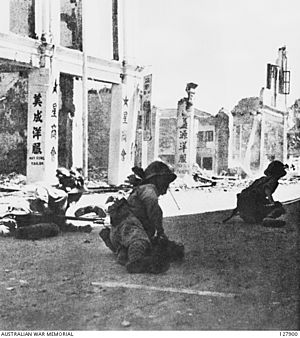
The continuous development of Johor Bahru was, however, halted when the Japanese under General Tomoyuki Yamashita invaded the town on 31 January 1942. As the Japanese had reached northwest Johor by 15 January, they easily captured major towns of Johor such of Batu Pahat, Yong Peng, Kluang and Ayer Hitam. The British and other Allied forces were forced to retreat towards Johor Bahru; however, following a further series of bombings by the Japanese on 29 January, the British retreated to Singapore and blew up the causeway the following day as a final attempt to stop the Japanese advance in British Malaya. The Japanese then used the Sultan's residence of Bukit Serene Palace located in the town as their main temporary base for their future initial plans to conquer Singapore while waiting to reconnect the causeway. The Japanese chose the palace as their main base because they already knew the British would not dare to attack it as this would harm their close relationship with Johor.
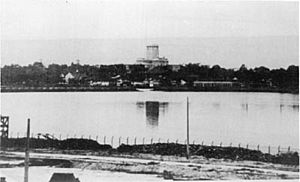
In less than a month, the Japanese repaired the causeway and invaded the Singapore island easily. Soon after the war ended in 1946, the town became the main hotspot for Malay nationalism in Malaya. Onn Jaafar, a local Malay politician who later became the Chief Minister of Johor, formed the United Malay National Organisation party on 11 May 1946 when the Malays expressed their widespread disenchantment over the British government's action for granting citizenship laws to non-Malays in the proposed states of the Malayan Union. An agreement over the policy was then reached in the town with Malays agreeing with the dominance of economy by the non-Malays and the Malays' dominance in political matters being agreed upon by non-Malays. Racial conflict between the Malay and non-Malays, especially the Chinese, is being provoked continuously since the Malayan Emergency.
Post-independence
After the formation of the Federation of Malaysia in 1963, Johor Bahru continued as the state capital and more development was carried out, with the town's expansion and the construction of more new townships and industrial estates. The Indonesian confrontation did not directly affect Johor Bahru as the main Indonesian landing point in Johor was in Labis and Tenang in Segamat District as well Pontian District. There was only one active Indonesian spy organisation in the town, known as Gerakan Ekonomi Melayu Indonesia (GEMI). They frequently engaged with the Indonesian communities living there to contribute information for Indonesian commandos until the bombing of the MacDonald House in Singapore in 1965. By the early 1990s, the town had considerably expanded in size, and was officially granted a city status on 1 January 1994. Johor Bahru City Council was formed and the city's current main square, Dataran Bandaraya Johor Bahru, was constructed to commemorate the event. A central business district was developed in the centre of the city from the mid-1990s in the area around Wong Ah Fook Street. The state and federal government channelled considerable funds for the development of the city—particularly more so after 2006, when the Iskandar Malaysia was formed. However, more than ten years of unbridled building construction in Iskandar, especially of higher-end high-rise apartments and commercial property, has led to a serious glut of such property in the region. Occupancy of high-rise accommodation has been predicted to fall to 50 percent, and commercial property to 65 percent, by the end of 2019 due to continued incoming supply.
Governance
As the capital city of Johor, the city plays an important role in the economic welfare of the entire state's population. There is one member of parliament (MP) representing the single parliamentary constituency (P.160) in the city. The city also elects two representatives to the state legislature from the state assembly districts of Larkin and Stulang.
Local authority and city definition
The city is administered by the Johor Bahru City Council. The current mayor is Dato' Haji Mohd Noorazam bin Dato' Haji Osman, which took office since 15 August 2021. Johor Bahru obtained city status on 1 January 1994. The area under the jurisdiction of the Johor Bahru City Council includes Central District, Kangkar Tebrau, Kempas, Taman Sri Bahagia, Danga Bay, Taman Suria, Kampung Majidee Baru, Southkey, Taman Sri Tebrau, Taman Abad, Taman Sentosa, Banda Baru Uda, Taman Perling, Larkin, Majidee, Kampung Maju Jaya, Bandar Dato´ Onn, Seri Austin, Adda Heights, Taman Gaya, Taman Daya, Taman Bukit Aliff, Setia Tropika, Taman Johor, Taman Anggerik, Taman Sri Putra, Mount Austin, Pandan, Pasir Pelangi, Pelangi, Taman Johor Jaya, Taman Molek, Permas Jaya, Rinting, Tampoi, Tasek Utara and Tebrau. This covers an area of 220 square kilometres (85 sq mi). Currently there are 11 council members in the city council, which consists of 3 Amanah members, 3 Bersatu members, 3 DAP members and 2 PKR members. In August 2021, mayor Adib Azhari Daud was arrested and taken into custody for allegedly accepting bribes from contractors while overseeing development of Johor Bahru. The arrest marks the first time an active Johor mayor has been arrested.
Courts of law and legal enforcement
The city high court complex is located along Dato' Onn Road. The Sessions and Magistrate Courts is located on Ayer Molek Road, while another court for Sharia law is located on Abu Bakar Road. The Johor (state) Police Contingent Headquarters is located on Tebrau Road. Johor Bahru's Southern District police headquarters, which also operates as a police station, is on Meldrum Road in the city centre. The Johor Bahru Southern District traffic police headquarters is a separate entity along Tebrau Road, close to the city centre. Johor Bahru's Northern District police headquarters and Northern District Traffic Police headquarters are co-located in Skudai, about 20 km north of the city centre. There are around eleven police stations and seven police substations (Pondok Polis) in the greater Johor Bahru area. Johor Bahru Prison was located in the city along Ayer Molek Road, but was closed down after 122 years operation in December 2005, its function being transferred to an expanded prison in the town of Kluang about 110 km from Johor Bahru. Other temporary lock-ups or prison cells are available in most police stations in the city, as in other parts of Malaysia.
Geography
Johor Bahru is located along the Straits of Johor at the southern end of Peninsular Malaysia. Originally, the city area was only 12.12 km2 (4.68 sq mi) in 1933 before it was expanded to over 220 km2 (85 sq mi) in 2000.
Climate
The city has an equatorial climate with consistent temperatures, a considerable amount of rain, and high humidity throughout the course of the year. An equatorial climate is a tropical rainforest climate more subject to the Intertropical Convergence Zone than the trade winds and with no cyclone. Daily average temperatures range from 26.4 °C (79.5 °F) in January to 27.8 °C (82.0 °F) in April with an average annual rainfall of around 2,350 mm (93 in). The wettest months, with 19 to 25 percent more rain than average, are April, November and December. Although the climate is relatively uniform, it does show some seasonal variation due to the effects of monsoons, with noticeable changes in wind speed and direction, cloud cover and amount of rainfall. There are two monsoon periods each year, the first one between mid-October and January, which is the north-east Monsoon. This period is characterised by heavier rainfall and wind from the north-east. The second one is the south-west Monsoon, which hardly affects the rainfall in Johor Bahru, where winds are from the south and south-west. This occurs between June and September.
| Climate data for Johor Bahru (Senai International Airport, 2016–2023) | |||||||||||||
|---|---|---|---|---|---|---|---|---|---|---|---|---|---|
| Month | Jan | Feb | Mar | Apr | May | Jun | Jul | Aug | Sep | Oct | Nov | Dec | Year |
| Mean daily maximum °C (°F) | 31.6 (88.9) |
32.3 (90.1) |
33.2 (91.8) |
33.4 (92.1) |
33.1 (91.6) |
32.0 (89.6) |
32.0 (89.6) |
32.1 (89.8) |
32.2 (90.0) |
32.4 (90.3) |
32.0 (89.6) |
31.8 (89.2) |
32.3 (90.2) |
| Mean daily minimum °C (°F) | 23.6 (74.5) |
23.5 (74.3) |
23.8 (74.8) |
24.3 (75.7) |
24.7 (76.5) |
24.3 (75.7) |
24.1 (75.4) |
24.0 (75.2) |
23.8 (74.8) |
24.0 (75.2) |
23.9 (75.0) |
23.9 (75.0) |
24.0 (75.2) |
| Average precipitation mm (inches) | 162.6 (6.40) |
139.8 (5.50) |
203.4 (8.01) |
232.8 (9.17) |
215.3 (8.48) |
148.1 (5.83) |
177.0 (6.97) |
185.9 (7.32) |
190.8 (7.51) |
217.7 (8.57) |
237.6 (9.35) |
244.5 (9.63) |
2,355.5 (92.74) |
| Average precipitation days (≥ 1.0 mm) | 11 | 9 | 13 | 15 | 15 | 12 | 13 | 13 | 13 | 16 | 17 | 15 | 162 |
| Source 1: Meteomanz | |||||||||||||
| Source 2: World Meteorological Organisation (precipitation 1974–2000) | |||||||||||||
Demographics
Johor Bahru has an official demonym where people are commonly referred to as "Johor Bahruans". The terms "J.B-ites" and "J.B-ians" have also been used to a limited extent. People from Johor are called Johoreans.
Ethnicity and religion
The Malaysian Census in 2010 reported the population of Johor Bahru as 497,067. The city's population today is a mixture of three main ethnicities – Malays, Chinese and Indians- along with other bumiputras. Malays comprise a plurality of the population at 240,323, followed by Chinese totalling 172,609, Indians totaling 73,319 and others totalling 2,957. Non-Malaysian citizens form a population of 2,585. The Malays in Johor Bahru are strongly related to the neighbouring Riau Malays in Riau Islands, Indonesia with significant populations of Javanese, Bugis and Banjarese among the local Johorean Malay population. The Chinese mainly are from the majority Hokkien and Teochew (among the local Chinese), while the Indian community mainly and predominantly are Tamils, there are also small populations of Telugus, Malayalis and Sikh Punjabis. The Malays are majority Muslims, while the Chinese are predominantly Buddhists/Taoists and the Indians were mostly Hindus despite there is also a small numbers from the two ethnic groups that are Christians and Muslims. A small number of Sikhs, Animists and secularists can also be found in the city.
The following is based on Department of Statistics Malaysia 2010 census.
| Ethnic groups in Johor Bahru, 2010 | ||
|---|---|---|
| Ethnicity | Population | Percentage |
| Malay | 240,323 | 48.35% |
| Other Bumiputras | 5,374 | 1.98% |
| Chinese | 172,609 | 34.73% |
| Indian | 73,319 | 13.70% |
| Others | 2,957 | 0.59% |
| Non-Malaysian | 2,585 | 1.57% |
| Total | 497,067 | 100.00% |
Languages
The local ethnic Malays speak the Malay language, while the language primarily spoken by the local Chinese is Mandarin Chinese. The Chinese community is represented by several dialect groups: Hokkien and Teochew.
The Indian community predominantly speaks Tamil, with a minority of Malayalam, Telugu and Punjabi speakers. The English language (or Manglish) is also used considerably, albeit more so among the older generation, who have attended school during the British rule.
Economy
Johor Bahru is one of the fastest-growing cities in Malaysia after Kuala Lumpur. It is the main commercial centre for Johor and is located in the Indonesia–Malaysia–Singapore Growth Triangle. Tertiary-based industry dominates the economy with many international tourists from the regions visiting the city. It is the centre of financial services, commerce and retail, arts and culture, hospitality, urban tourism, plastic manufacturing, electrical and electronics and food processing. The main shopping districts are located within the city, with a number of large shopping malls located in the suburbs. Johor Bahru is the location of numerous conferences, congress and trade fairs, such as the Eastern Regional Organisation for Planning and Housing and the World Islamic Economic Forum. The city is the first in Malaysia to practise a low-carbon economy.
The city has a very close economic relationship with Singapore. There are around 3,000 logistic lorries crossing between Johor Bahru and Singapore every day for delivering goods between the two sides for trading activities. Many residents in Singapore frequently visit the city during the weekends; some of them have also chosen to live in the city. Many of the city's residents work in Singapore.
Transportation
Land
The internal roads linking different parts of the city are mostly federal roads constructed and maintained by Malaysian Public Works Department. There are five major highways linking the Johor Bahru Central Business District to outlying suburbs: Tebrau Highway and Johor Bahru Eastern Dispersal Link Expressway in the northeast, Skudai Highway in the northwest, Iskandar Coastal Highway in the west and Johor Bahru East Coast Highway in the east. Pasir Gudang Highway and the connecting Johor Bahru Parkway cross Tebrau Highway and Skudai Highway, which serve as the middle ring road of the metropolitan area. The Johor Bahru Inner Ring Road, which connects with the Sultan Iskandar customs complex, aids in controlling the traffic in and around the central business district. Access to the national expressway is provided through the North–South Expressway and Senai–Desaru Expressway. The Johor–Singapore Causeway links the city to Woodlands, Singapore with a six-lane road and a railway line terminating at the Southern Integrated Gateway.
Bus
The main bus terminal of the city is the Larkin Sentral located in Larkin. Other bus terminals include Taman Johor Jaya Bus Terminal and Ulu Tiram Bus Terminal. Larkin Sentral has direct bus services to and from many destinations in West Malaysia, southern Thailand and Singapore, while Taman Johor Jaya and Ulu Tiram Bus Terminals serve local destinations. Major bus operators in the city are Causeway Link, Maju and S&S. It is possible to get around the city by bus, though the frequency of the bus might be an issue.
Taxi
Two types of taxis operate in the city; the main taxi is either in red and yellow, blue, green or red while the larger, less common type is known as a limousine taxi, which is more comfortable but expensive. Most taxis in the city do not use their meter.
Railway
The city is served by two railway stations, which are Johor Bahru Sentral railway station and Kempas Baru railway station. Both stations serve train services to Kuala Lumpur and Singapore. In 2015, a new shuttle train service operated by Keretapi Tanah Melayu (KTM) was launched providing transport to Woodlands in Singapore.
Air
The city is served by Senai International Airport located at the neighbouring Senai town and connected through Skudai Highway. Four airlines, AirAsia (and its subsidiaries Indonesia AirAsia and Thai AirAsia), Firefly, Malaysia Airlines, Batik Air Malaysia and formerly Xpress Air, provide flights domestically as well as international flights to Jakarta Soekarno–Hatta, Surabaya, Hồ Chí Minh City, and Bangkok Don Mueang. The nearest major airport is Changi Airport in Singapore located 36.3 km from the city centre.
Sea
Boat services are available to ports in Batam and Bintan Islands in Indonesia from Stulang Laut Ferry Terminal, located near the suburb of Stulang.
Other utilities
Healthcare
There are three public hospitals, four health clinics and thirteen 1Malaysia clinics in Johor Bahru. Sultanah Aminah Hospital, which is located along Persiaran Road, is the largest public hospital in Johor Bahru as well as in Johor with 989 beds. Another government funded hospital is the Sultan Ismail Specialist Hospital with 700 beds. Another large private health facility is the KPJ Puteri Specialist Hospital with 158 beds. Further healthcare facilities are currently being expanded to improve healthcare services in the city.
Education
Many government or state schools are available in the city. The secondary schools include English College Johore Bahru, Sekolah Menengah Kebangsaan Engku Aminah, Sekolah Menengah Kebangsaan Sultan Ismail, Sekolah Menengah Infant Jesus Convent, Sekolah Menengah Kebangsaan (Perempuan) Sultan Ibrahim and Sekolah Menengah Saint Joseph. There are also a number of international schools in the city. These include Marlborough College Malaysia, Shattuck-St. Mary’s Forest City International School, Raffles American School, Sunway International School. The other private universities are Newcastle University Medicine Malaysia, University of Reading Malaysia, University of Southampton Malaysia. There are also a number of private college campuses and one polytechnic operating in the city; these are Crescendo International College, KPJ College, Olympia College, Sunway College Johor Bahru, Taylor's College and College of Islamic Studies Johor.
Libraries
The Johor State Library, also known as the Johor Public Library Corporation headquarters is the main library in the state, located off Yahya Awal Road. Another public library branch is the University Park in Kebudayaan Road, while there are other libraries or private libraries in schools, colleges, and universities. Two village libraries are available in the district of Johor Bahru.
Culture and leisure
Attractions and recreation spots
Cultural attractions
There are a number of cultural attractions in Johor Bahru. The Royal Abu Bakar Museum located within the Grand Palace building is the main museum in the city. The Johor Bahru Kwong Siew Heritage located in Wong Ah Fook Street housed the former Cantonese clan house that was donated by Wong Ah Fook. The Foon Yew High School houses many historical documents of the city history with a Chinese cultural heritage. The Johor Bahru Chinese Heritage Museum on Ibrahim Road includes the history of Chinese migration to Johor along with a collection of documents, photos, and other artefacts.
The Johor Art Gallery in Petrie Road is a house gallery built in 1910, known as the house for the former third Chief Minister of Johor, Abdullah Jaafar. The house features old architecture and became the centre for the collection of artefacts related to Johor's cultural history since its renovation in 2000.
Historical attractions
The Grand Palace is one of the historical attractions in the city, and is an example of Victorian-style architecture with a garden. Figure Museum is another historical colonial building since 1886 which ever become the house for the Johor first Menteri Besar Jaafar Muhammad; it is located on the top of Smile Hill (Bukit Senyum). The English College (now Maktab Sultan Abu Bakar) established in 1914 was located close to the Sungai Chat Palace before being moved to its present location at Sungai Chat Road; some of the ruins are visible at the old site. The Sultan Ibrahim Building is another historical building in the city; built in 1936 by British architect Palmer and Turner, it was the centre of the administration of Johor as since the relocation from Telok Blangah in Singapore, the Johor government never had its own building. Before the current railway station was built, there was Johor Bahru railway station (formerly Wooden Railway) which has now been turned into a museum after serving for 100 years since the British colonial era.
Sultan Abu Bakar State Mosque, located along Skudai Road, is the main and the oldest mosque in the state. It was built with a combination of Victorian, Moorish and Malay architectures. The Johor Bahru Old Chinese Temple, located on the Trus Road, dedicated to the Five Patron Deities from the five Southern Chinese Clans (Hokkien, Teochew, Hakka, Cantonese & Hainanese) in the city. It was built in 1875 and renovated by the Persekutuan Tiong Hua Johor Bahru (Johor Bahru Tiong Hua Association) in 1994–95 with the addition of a small L-shaped museum in one corner of the square premises. The Wong Ah Fook Mansion, the home of the late Wong Ah Fook, was a former historical attraction. It stood for more than 150 years but was demolished illegally by its owner in 2014 to make way for a commercial housing development without informing the state government. Other historical religious buildings include the Arulmigu Sri Rajakaliamman Hindu Temple, Sri Raja Mariamman Hindu Temple, Gurdwara Sahib and Church of the Immaculate Conception.
Leisure and conservation areas
The Danga Bay is a 25 kilometres (16 mi) area of recreational waterfront. There are around 15 established golf courses, of which two offer 36-hole facilities; most of these are located within resorts. The city also features several paintball parks which are also used for off-road motorsports activities.
The Johor Zoo is one of the oldest zoos in Malaysia; built in 1928 covering 4 hectares (9.9 acres) of land, it was originally called "animal garden" before being handed to the state government for renovation in 1962. The zoo has around 100 species of animals, including wild cats, camels, chimpanzees, gorillas, orangutans, and tropical birds. Visitors can participate in activities such as horse riding or using pedalos. The largest park in the city is Independence Park.
Other attractions
Dataran Bandaraya was built after Johor Bahru was proclaimed as a city. The site features a clock tower, fountain and a large field. The Wong Ah Fook Street is named after Wong Ah Fook. The Tan Hiok Nee Street is named after Tan Hiok Nee, who was the leader of the former Ngee Heng Kongsi, a secret society in Johor Bahru. Together with the Dhoby Street, both are part of a trail known as Old Buildings Road; they feature a mixture of Chinese and Indian heritages, reflected by their forms of ethnic business and architecture.
Shopping
The Mawar Handicrafts Centre, a government-funded exhibition and sales centre, is located along the Sungai Chat road and sells various batik and songket clothes. Opposite this is the Johor Area Rehabilitation Organisation (JARO) Handicrafts Centre which sells items such as hand-made cane furniture, soft toys and rattan baskets made by the physically disabled.
Entertainment
The oldest cinema in the city is the Broadway Theatre which mostly screens Tamil and Hindi movies. There are around other five cinemas available in the city with all of them located inside shopping malls.
Sports
The city's main association football club is a Johor Darul Ta'zim F.C. Its home stadium is Sultan Ibrahim Stadium has a capacity of around 40,000. There is also a futsal centre, known as Sports Prima, which has eight minimum-sized FIFA approved futsal courts; it is the largest indoor sports centre in the city.
Radio stations
Two radio stations have their offices in the city: Best FM (104.1) and Johor FM (101.9).
International relations
Several countries have set up their consulates in Johor Bahru, including Indonesia and Singapore, while Japan has closed its consular office since 2014.
Twin towns – Sister cities
Johor Bahru's sister cities are:
 Changzhou, Jiangsu, China
Changzhou, Jiangsu, China Kuching, Sarawak, Malaysia
Kuching, Sarawak, Malaysia Istanbul, Türkiye (Turkey)
Istanbul, Türkiye (Turkey)
Notable people
- Christina Jordan (born 1962), Malaysian-born British politician
- Vivien Yeo (born 1984), Malaysian actress based in Hong Kong
- Gin Lee (born 1987), Malaysian singer based in Hong Kong
- Robert Kuok (born 1923), Business magnate, investor, and philanthropist. Top 100 wealthiest people in world.
- Ng Tze Yong (born 2000), national badminton player
- Ronny Chieng (born 1985), Malaysian comedian and actor based in United States
- Tunku Abdul Rahman Hassanal Jeffri (born 1993), racing driver and member of the Johor Royal Family
- Sebastian Francis, (born 1959), fifth bishop of Roman Catholic Diocese of Penang and cardinal of the Catholic Church
See also
 In Spanish: Johor Bahru para niños
In Spanish: Johor Bahru para niños







